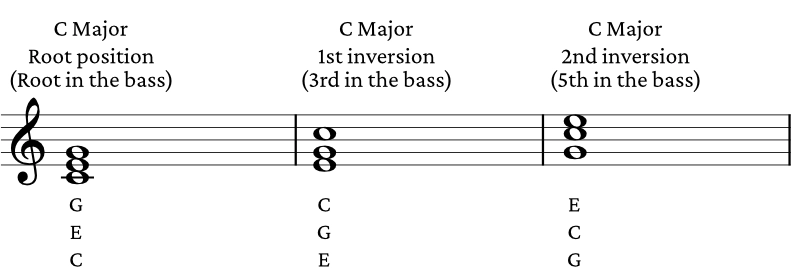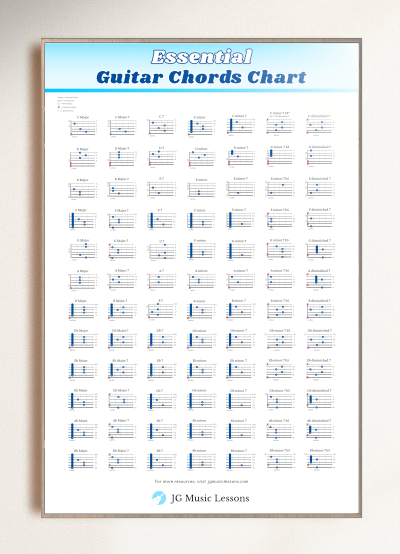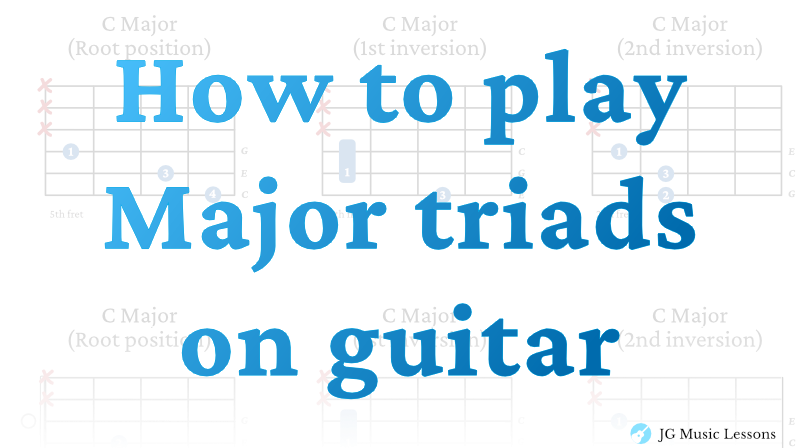Triads form the backbone of most chords and are a great tool for outlining harmony, building melodies, and improvising.
While the concept is simple in theory, learning how to apply triads all over the guitar neck takes practice but it’s well worth the effort.
In this lesson, you’ll learn how to play Major triads, explore their inversions on different string sets, practice arpeggio shapes across the fretboard, and work through pattern based exercises to lock them in.
Grab your guitar and let’s get started!
✨PDF included with the Pro Membership
Major Triad Formula
A Major triad is a chord built on 3 notes using the chord tones 1, 3, and 5. For example, a C Major triad has the notes C, E, and G. The formula for a Major triad is 2 whole steps, then 1.5 whole steps. See the formula in the image below.

Major Triads Chart
With this formula in mind, here is a chart of the 12 Major triad chords.
| Major triad chord | 1 | 3 | 5 |
|---|---|---|---|
| C Major triad | C | E | G |
| D Major triad | D | F# | A |
| E Major triad | E | G# | B |
| F Major triad | F | A | C |
| G Major triad | G | B | D |
| A Major triad | A | C# | E |
| B Major triad | B | D# | F# |
| Db Major triad | Db | F | Ab |
| Eb Major triad | Eb | G | Bb |
| Gb Major triad | Gb | Bb | Db |
| Ab Major triad | Ab | C | Eb |
| Bb Major triad | Bb | D | F |
Major Triad Shapes on Different Strings
The first step to learning Major triads is knowing the different ways to play it on one guitar string. We’ll use the C Major triad for these examples.
Major Triads – 6th String
Here are three ways you can play a C Major triad starting on the 6th string below.

Major Triads – 5th String
The three shapes starting on the 5th string look the same as the ones on the 6th string.

Major Triads – 4th String
The Major triad shapes starting on the 4th string look slightly different than the 6th and 5th string triad shapes.

Major Triads – 3rd String
The Major triad shapes starting on the 3rd string also have unique shapes that look different from the ones on the other strings.

All of these Major triad shapes can be applied to any root note on the same string. Make sure to adjust the fingerings whenever open strings are included.
Major Triad Inversions
After learning the Major triads starting on each string, the next step is to learn the chord inversions. In short, a chord inversion is when you play a chord starting on different chord tones.
For example:
- Root position is when you on the root note in the bass (lowest note).
- 1st inversion is when you have the 3rd of the chord in the bass.
- 2nd inversion is when you have the 5th of the chord in the bass.
Here is what this looks like in music notation for a C Major triad.

Now let’s look at how to play a Major triad and it’s inversions starting on different strings below.

Major Triads Guitar Chord Charts
The following charts show you what the Major triads look like in chord form for each string.
Major Triad Chords – 6th String

Major Triad Chords – 5th String

Major Triad Chords – 4th String

Major Triad Chords – 3rd String

Again, when playing chords with open strings, make sure to adjust these fingerings to what is most comfortable for you.

Major Triad Arpeggios Shapes
For the previous examples, we’ve been learning Major triads horizontally across one string. In this section, we’ll be looking at the vertical triad shapes throughout the fretboard. Again, we’ll be using the C Major triad for the following examples.
Arpeggio Shape 1

Arpeggio Shape 2

Arpeggio Shape 3

Arpeggio Shape 4

Arpeggio Shape 5

Keep in mind that fingerings change whenever you have open strings included in a triad. Experiment with different fingerings to see what works best for you.
Connecting Arpeggio Shape – Two octaves
Here is an example of how to connect the Major triad shapes throughout the fretboard. We’ll be using the E Major triad for this example.

Major Triad Exercises
The following exercises can be applied to any of the arpeggio shapes on the fretboard. Here are some pattern exercises over one area of the fretboard using the C Major triad.
3 Note Pattern
After playing three consecutive notes of a triad, repeat the pattern on the second to last note (C, E, G then E, G, C, etc…)

4 Note Pattern
After playing four consecutive notes of a triad, repeat the pattern on the second to last note (C, E, G, C then G, C, E, G, etc…)

Note Skipping Pattern
For this pattern, you skip one note of the triad then repeat the pattern on the chord tone below it (C, G, then E, C, etc…)

Connecting Major Triad Shapes on the Fretboard
The chart below maps out a C major triad across all six strings so you can see how the shapes connect across the fretboard.
The goal is to learn as many variations of a chord as possible so you can move around the neck with confidence. These shapes are movable so you can use them for any Major chord by shifting the root to the correct fret.
Orange circles indicate the root notes, which serve as visual anchors as you move through the shapes.

Try saying the chord tone (root, 3rd, 5th) aloud as you play each note to reinforce theory and fretboard knowledge.
Once you see all of the triad notes on the fretboard, you may notice that some shapes are similar to basic chord shapes. By learning different ways of playing a Major chord, it will help you to visualize the triad notes much easier.
✨PDF included with the Pro Membership
Wrapping up
Triads are a simple yet powerful way to outline the harmony of a chord. In this lesson, we covered how to play Major triads starting on different strings, their inversions, arpeggio shapes across the fretboard, and pattern based exercises to help you practice them.
To master Major triads on guitar, try applying these exercises in different keys. This will strengthen your fretboard visualization and help you connect musical ideas more fluidly.
Want to keep going? Check out these related lessons:
This lesson builds on: A simple guide on learning triads on guitar.
📘 Get the free guitar practice guide here!
All the best,
JG Music Lessons
📙 Kickstart your guitar playing with our step by step guide: Guitar Essentials.
🎸 Looking for a travel or half-sized guitar? See this one.
🛠 See our other music recommendations.
🤝 Support the site to help us to create better content for you!
Level up with the FREE guitar practice guide and effectively improve your playing! 🎸
Get it sent to your email!



